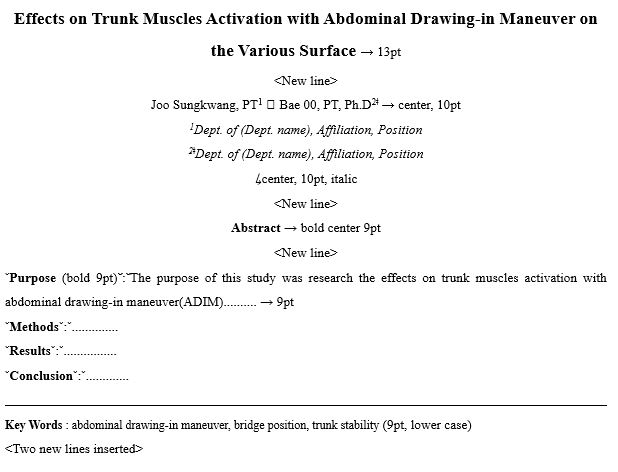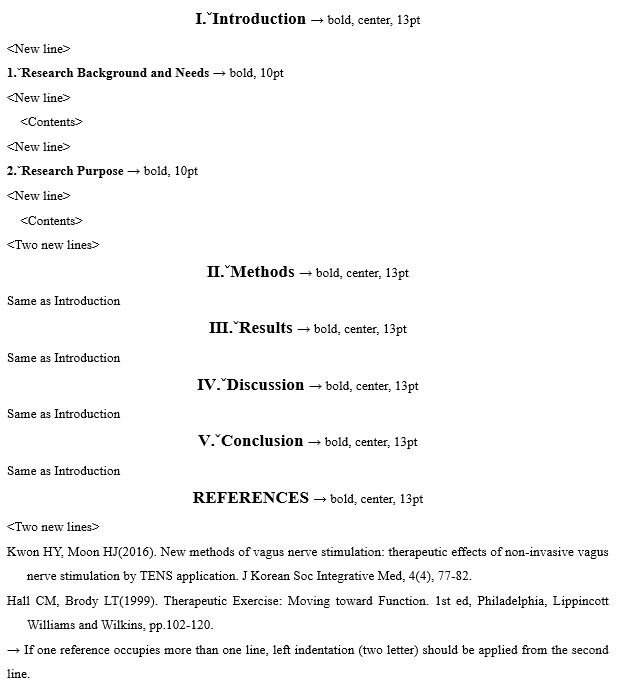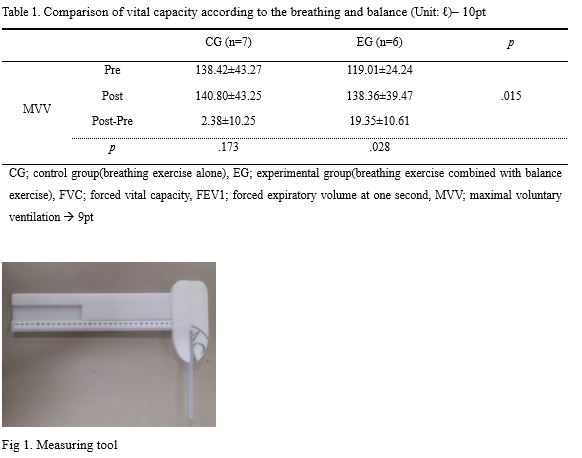Regulation of Paper Submission
in the Korean Society of Integrative Medicine
1. (Purpose)
This regulation aims to set forth the overall matters concerning the guidelines of paper submission in relation to publication of the journal based on the integrative medicine concept prescribed in Articles 2 (1), (2), and (3) of the articles of association in the Korean Society of Integrative Medicine (hereinafter referred to as KSIM).
2. (Qualification of Submitters)
The submitters and co-authors shall be in principle the members of the KSIM. Provided, that this provision shall not apply to invited papers.
3. (Qualification of Papers)
Papers submitted shall be novel research papers without previous publication in other journals or expected to publish in the future.
4. (Scope of Papers)
The journal of KSIM is an academic journal of the KSIM that publishes integrative medicine-related papers in a range of musculoskeletal and nervous systems, psychosocial and health science, health sports etc.
5. (Category of Papers)
The submitted papers are categorized into three types according to the characteristics: 1) Original articles, 2) Case study, and 3) Review.
6. (Writing Manuscripts)
The manuscripts shall be written in English as the Microsoft Word format using spelling checks via computers.
7. (Editing Papers)
- Letter size: Unless otherwise specified in the example below, 10-point font size is used.
- Paper size: A4 210 x 297 mm
- Paper direction: Narrow
- Paper margin: Default setting
- Line spacing: 0 line
- Indentation: left one letter
The above guideline is the basic format and more details are followed in the next example.
8. (Content Editing)
1) Paper Title is put first followed by Abstract, Introduction, Research Method, Results, Discussion, Conclusions, and Reference with one line spacing respectively. The font should be Times New Roman. The definitions that are not mentioned in the below shall follow the default value in MS Word.
2) Paper Title
- (1) Letter and paragraph shapes
Times New Roman, size (13pt), style (bold), alignment (center), indentation (0) - (2) If a sub-title is used, a colon (:) shall be put in the end of the main title followed by a sub-title.
- (3) Capitalize the first letter of every word except articles, prepositions, and conjunctions. Note that when a sub-title is added, a colon (:) is marked in the end of the title, and only the first letter of the first word is capitalized, and the rest are all in lower case.
3) Abstract
-
(2) Abstract should be around 300 words in total.
- ① Times New Roman (9pt), style (normal), alignment (justify), and indentation (0)
- ② The four components: Purpose, Methods, Results, and Conclusion should be bold font style and a colon (:) should be put at the end of each component title followed by the contents with normal font style.
- ③ A new line should be put between the components.
- ④ The number of words in the abstract can be checked by Review => Word Counts in MS Word.
- ⑤ More than five words should be inserted, and each of the key words should be separated by a comma (,)..Each key word should be written in lower case.
- ⑥ Key Words should be size (9pt), font style (normal), alignment (justify), and indentation (0).
-
⑦ The email address of corresponding author should be put below Key words.
[Sample] click image to view larger
4) Main Body
- (1) Font (Times New Roman), size (10pt), font style (normal), alignment (justify), and indentation (left one letter)
-
(2) The numbering system should be I., 1., 1)., (1), and A..
- - I. Ⅱ. And Ⅲ. should be font size (13pt), font style (bold), alignment (center), and indentation (0). Two lines above the number and one line below the number should be placed.
- - 1. 2. and 3. should be font size (10pt), font style (bold), alignment (justify), and indentation (0). One new line is put between numbers such as 1. and 2.
- - The other numbers such as 1) and (1) should be font size (10pt), font style (normal), alignment (justify), and indentation (left one letter).
-
(3) The description of equipment used in research should be put in the main body as follows:
- Used equipment (equipment name, manufacturer, country) - (4) The consent details of the study subject in the experiment must be included in the study method (excluding animal experiments).
- (5) The citation information in the main body should be inserted in the relevant location as author's family name (publication year). Superscripts are not used. When two or more citations are listed, each of the citations is separated by semi colon (;) and listed in alphabetical order.
-
[Sample] click image to view larger[Sample]- ① For single author: ......reported this (Hong, 2012).
- ② For two authors: .....reported this (Hong & Lee, 2012; Tomberlin & Saunders, 2012).
- ③ For more than three authors: .......reported this (Hong et al., 2012; Tomberlin et al., 2012).
5) Table, figure, and photo
- - Captions and descriptions of all tables, figures, and photos shall be written in English, and tables and figures should follow for example Table 1 and Fig. 1, respectively.
- - A vertical line should not be inserted in tables, and the locations of unit and calculation signs should be aligned. The uppermost horizontal line should be 1 ½ pt. solid line and the lowermost horizontal line should be ¼ pt. solid line and in-between horizontal lines should be ¼ pt. dotted lines.
- - Texts and footnotes inside tables except for table captions should be font size (9 pt.), font style (normal), alignment (table and figure captions and abbreviations: justify, texts inside tables: center), and indentation (0).
- - The captions of table and figure should be above the table and below the figure, respectively.
- - Abbreviations should have corresponding footnotes below the table.
-
[Sample] click image to view larger
6) References
- - Reference citations should be made by quoting recent (within 10 years) papers.
- - References title should be font size (13 pt.), font style (bold), and alignment (center).
- - A list of References should be sorted by authors’ family names in alphabetical order.
- - The contents in References should be font size (10pt), font style (normal), alignment (justify), and indentation (left two letters).
- - For author names, full last name is indicated first, and only the initial (first capital) is marked for first name and middle name (Radin EL.)
- - If the number of authors are three or less, all authors are shown. However, if the number of authors are four or more, only the first three authors are shown, and the rest are indicated as “et al.”
- - The names of foreign journals are denoted according to the Index Medicus abbreviations, and if an abbreviation is not found in the Index Medicus, its original journal name is used without abbreviation.
- - Only the first letter of paper or book title is capitalized, and the rest should be lower case.
-
Cited reference Referencing style Main Body One author .....Reported this (Kim, 2018). Two authors ....Reported this (Bae & Kim, 2017; Jang & Joo, 2016) Three or more authors ....reported this (Kim et al., 2018; Jang et al., 2018). References Author name (publication year). Title. Journal name, volume (issue), first cited page-last cited page. Kim JP, Joo SW, Bae WS, et al(2012). Relationship between sign and symptoms of mandibular dysfunction in adolescents a review. Community Dent Oral Epidermiol, 14(4), 225-230. -
(1) Referencing for academic papers
- Author name (publication year). Paper title. Graduation school, Country, Masters (Doctoral.) thesis[Sample] click image to view larger -
(2) Referencing for books
- Author name (publication year). Book title. Edition, Publishing location, Publisher, Page range[Sample] click image to view larger -
(3) Referencing for magazines (periodicals)
- Author name (publication year). Title. Magazine name, volume (issue), page range[Sample] click image to view larger -
(4) Referencing for chapter in books[Sample] click image to view larger -
(5) Referencing for academic papers that are periodicals (without doi)
- Author name (publication year). Title. Journal name, volume (issue), first cited page-last cited page[Sample] click image to view larger -
(6) Referencing for academic papers that are periodicals (if doi)
- Author name (publication year). Title. Journal name, volume (issue), first cited page-last cited page. Doi.[Sample] click image to view larger -
(7) Referencing for online publication
- Author name (publication year). Title. Journal name, volume (issue), Printed Online. Doi.[Sample] click image to view larger -
(8) Referencing for materials in the Internet
- Author. Title, Bibliography Data source, Data search date. Author and bibliography may be omitted if not found.[Sample] click image to view larger
-
9. (Manuscript Submission)
To submit a manuscript, Word document containing figures and tables should be submitted using the paper submission system (https://ksim.jams.or.kr) in the KSIM website (http://www.ksim.kr). The ownership of submitted manuscripts should belong to the KSIM, and submitted documents are not returned to authors.
10. (Strengthening Ethics in Research Papers)
Submitters should undertake the education of research ethic for main authors and paper plagiarism check in the KSIM website http://www.ksim.kr) and submit the original paper manuscript and written pledge of research ethic along with certificates of research ethic education and paper plagiarism check (revised in February 27 in 2016).
11. (Return of Manuscript)
Manuscripts that are deemed to be difficult in examination, editing, and printing due to papers that do not conform to the submission regulation, inclusion of blur or unclear photos will be returned to authors.
12. (Examination of Papers)
The reception date of submitted paper is deemed to be the arrival date to the KSIM. Submitted manuscripts are examined by examiners specialized in paper-specific subject matter according to the regulation and procedure of paper examination supervised by the Academic Editing Committee, which will decide publication or revision of papers according to the examination results.
13. (Request for Re-examination of Papers)
Authors who are requested to revise papers may apply for re-examination request with an attachment of evidence documents and materials that prove the valid reasons. The Academic Editing Committee shall deliberate on the re-examination request and decide whether the paper is published or revised.
14. (Paper Publication Fee)
Authors should pay a certain charge of publication fee set by the KSIM.
15. (Copyright)
The copyright of the published papers belongs to the KSIM.














